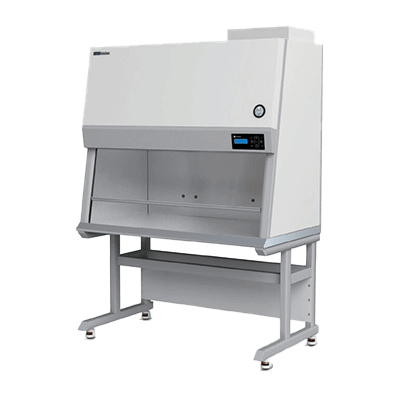What Is a Clean Bench?

A clean bench is an enclosed workbench that maintains a high level of cleanliness to prevent contamination from dust and airborne microorganisms.
Uses of Clean Benches
Clean benches are used for handling microorganisms, cells, and other materials that should not be contaminated by bacteria or relics from the outside.
For example, in the pharmaceutical field, clean benches are used for cultivating microorganisms and cells and preparing pharmaceutical products, while in the industrial field, clean benches are used for manufacturing electronic components such as semiconductors and liquid crystals, which require high precision.
There are two types of air blowing positions: from the front or from the ceiling. When blowing from the front, the air stays around the workers and equipment, and there is a possibility that the cleanliness level will decrease, so aseptic work such as culturing organisms is done by blowing from the ceiling.
Most clean benches are usually enclosed, but there are also clean benches without enclosures, which contribute to improved workability.
Principle of Clean Benches
To prevent dust and airborne microorganisms from mixing in, the inside of clean benches are kept at positive pressure (the pressure inside the bench is higher than the outside air pressure) to block the flow of air from outside to inside, and only air that has been cleaned by a HEPA filter or other high-performance filter with dust removal function is taken into the bench.
In general, the dust collection efficiency exceeds 99%.
The main air filter must be HEPA or ULPA, in addition to having no peeling or rusting of the wall surfaces. In addition, when handling acids, organic, and toxic gases, it is clearly stated that they must have a structure that allows exhaust through a predetermined route and that lighting and germicidal lamps must not be turned on at the same time unless there is an agreement.
HEPA Filter
HEPA stands for High Efficiency Particulate Air Filter.
Although it is an important component for maintaining cleanliness in clean rooms, its performance declines with use due to clogging. The general life is about 3 years, but it depends on the usage environment. It is important to maintain the cleanliness of the clean bench by periodically checking the performance of the filter to see if the air volume is flowing and if there are any cracks or cracks in the filter.
Difference Between Clean Benches, Draft Chamber, and Safety Cabinet
Draft chambers and safety cabinets are similar to clean benches and differ greatly in airflow and purpose of use.
Clean benches are used to prevent dust and other foreign matter from entering the sample, and their primary purpose is to protect the sample. In clean benches, the air inside a container that has become positively pressurized flows out through the window where the work is done, which may expose workers to radiation if they handle hazardous materials.
The primary purpose of a draft chamber is to protect workers because hazardous gases, etc., are treated with a scrubber and discharged out of the system via ducts. On the other hand, it is not suitable for maintaining a clean environment because atmospheric air enters inside the container. After all, the pressure inside the container is negative.
The safety cabinet sends filtered and normalized air into the container while safely exhausting it through an exhaust filter from an intake port separate from the work window. Therefore, safety cabinets can protect samples and workers at the same time and are used when handling viruses or bacteria that pose a biohazard risk.